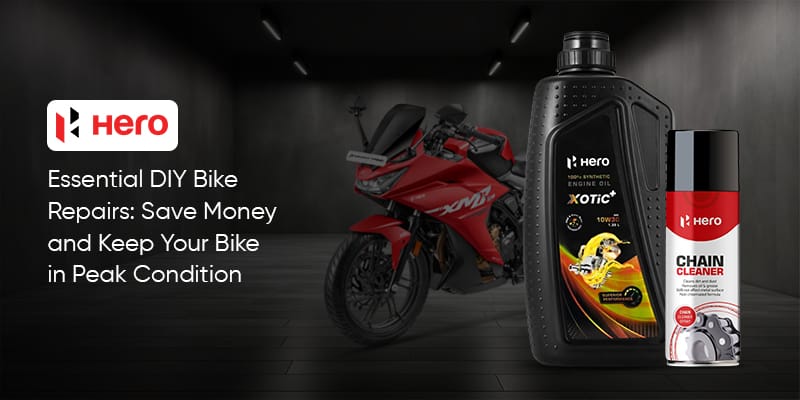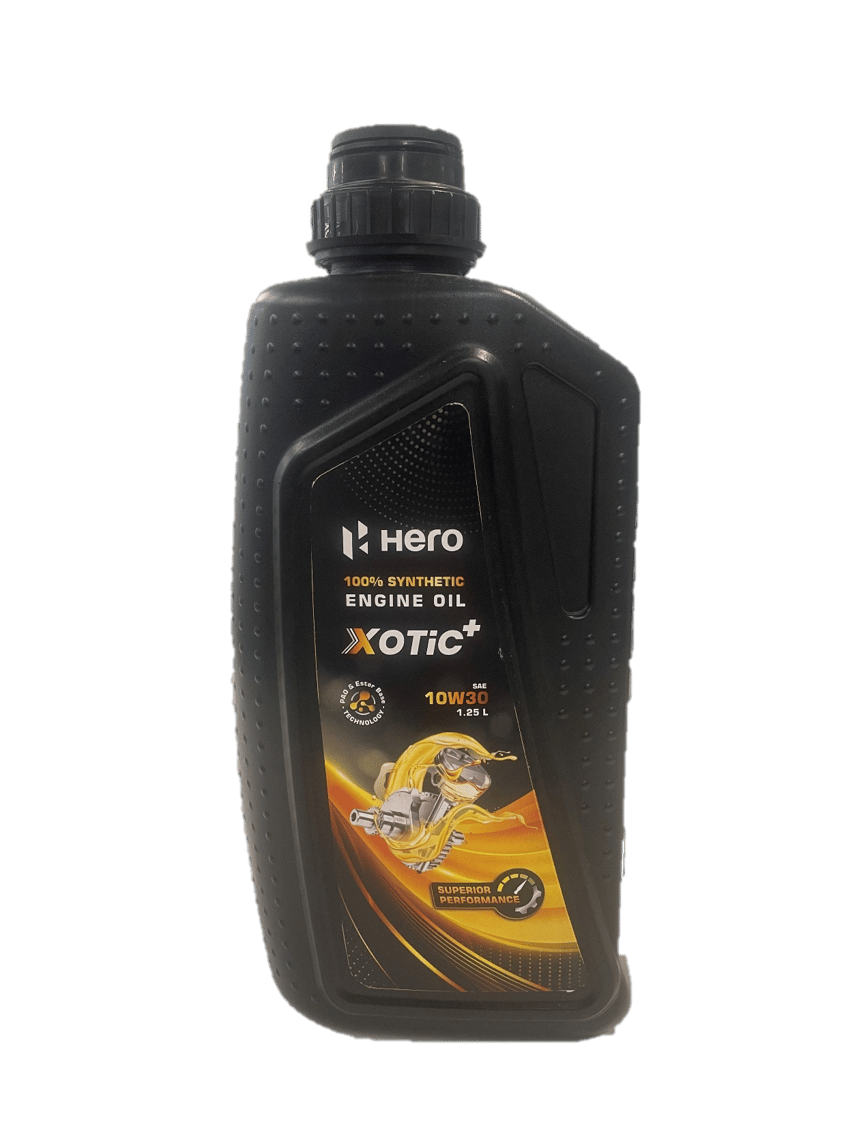Essential DIY Bike Repairs: Save Money and Keep Your Bike in Peak Condition
Maintenance

Table of Contents
- Essential DIY Bike Repairs: Save Money and Keep Your Bike in Peak Condition
- 1. Checking and Changing Engine Oil
- 2. Maintaining the Chain and Sprockets
- 3. Checking and Replacing Brake Pads
- 4. Inspecting and Changing the Air Filter
- 5. Battery Maintenance
- 6. Inspecting and Replacing Spark Plugs
- 7. Checking Tyre Pressure and Tread Depth
- 8. Adjusting Clutch and Throttle Play
- 9. Cleaning and Adjusting the Carburettor (For Carbureted Bikes)
- 10. Checking and Replacing Lights and Indicators
- Enhance your Repair with Hero eShop
Essential DIY Bike Repairs: Save Money and Keep Your Bike in Peak Condition
Owning a motorcycle is not just about enjoying the ride—it also comes with the responsibility of keeping it well-maintained. Regular servicing can be expensive, but with some basic DIY skills, you can handle essential repairs yourself. Learning DIY bike maintenance not only saves money but also ensures your bike stays in top shape for longer.
We’ll walk you through some simple repair techniques that will help you keep your bike running smoothly without frequent visits to the mechanic.
1. Checking and Changing Engine Oil
One of the most critical aspects of two wheeler maintenance tips is checking and changing the engine oil regularly. Fresh oil ensures smooth engine operation and prevents overheating.
How to Do It:
- Warm up the bike for a few minutes to make the oil flow easily.
- Locate the drain plug (usually at the bottom of the engine).
- Place a container under the plug and remove it to drain the old oil.
- Replace the drain plug and refill with fresh engine oil as per your bike’s specifications. You can check our range of engine oil to get the superior and genuine Hero MotoCorp engine oil.
- Check the oil level with the dipstick to ensure it’s at the correct level.
How Often?
Refer to your owner’s manual, but typically, engine oil should be changed every 3,000 to 5,000 km.

(Source)
2. Maintaining the Chain and Sprockets
A well-lubricated and properly tensioned chain is essential for a smooth ride. A loose or dry chain can cause jerks and reduce efficiency.
How to Do It:
- Put the bike on the centre stand or paddock stand.
- Use a brush to clean the chain with a degreaser.
- Apply chain lubricant or gear oil evenly while rotating the rear wheel.
- Adjust the chain tension if necessary by loosening the axle nuts and adjusting the tensioners.
How Often?
Lubricate every 500 km and check the tension regularly.
.png)
(Source)
3. Checking and Replacing Brake Pads
Brakes are the most crucial safety component of your motorcycle. And if you are wondering what regular maintenance should be done on a motorcycle, especially brakes, you should know that worn-out brake pads reduce stopping power, increasing the risk of accidents.
How to Do It:
- Inspect the brake pads; if they are less than 2-3mm thick, they need replacing.
- Use a spanner to remove the calliper and slide out the old brake pads.
- Insert new pads and reattach the calliper securely.
- Pump the brake lever a few times to ensure proper contact.
How Often?
Check every 5,000 km and replace when worn out.
4. Inspecting and Changing the Air Filter
A clean air filter improves fuel efficiency and engine performance. A clogged air filter can make your bike sluggish.
How to Do It:
- Locate the air filter housing (usually under the fuel tank or side panels).
- Remove the cover and take out the filter.
- If it’s a foam filter, clean it with mild detergent and let it dry before reinstalling.
- If it’s a paper filter, replace it with a new one.
How Often?
Check every 5,000 km and clean/replace as needed.
5. Battery Maintenance
A well-maintained battery ensures smooth starting and proper functioning of electrical components.
How to Do It:
- Check battery terminals for corrosion and clean them with a mixture of baking soda and water.
- Top up distilled water in lead-acid batteries if required.
- Keep the battery charged, especially if the bike is not used frequently.
How Often?
Check every month and recharge if necessary.
6. Inspecting and Replacing Spark Plugs
Spark plugs play a key role in fuel combustion. Worn-out spark plugs can cause misfires and poor fuel efficiency.
How to Do It:
- Locate the spark plug (usually on the engine head).
- Use a spark plug wrench to remove it.
- Check the electrode; if it’s black or worn, replace it with a new one.
- Screw in the new plug and tighten it just enough to prevent damage.
How Often?
Check every 10,000 km and replace if needed.
7. Checking Tyre Pressure and Tread Depth
Proper tyre maintenance ensures better grip, fuel efficiency, and safety.
How to Do It:
- Use a pressure gauge to check tyre pressure and adjust as per manufacturer recommendations.
- Inspect tread depth; if it’s below 2mm, consider replacing the tyre.
- Look for cracks or punctures and fix them promptly.
How Often?
Check tyre pressure weekly and tread depth monthly.
8. Adjusting Clutch and Throttle Play
A well-adjusted clutch and throttle improve riding comfort and control.
How to Do It:
- Locate the adjusters near the clutch lever and throttle grip.
- Tighten or loosen them to achieve smooth operation.
- Ensure the throttle snaps back quickly when released.
How Often?
Check every 1,000 km or if you feel discomfort while riding.
9. Cleaning and Adjusting the Carburettor (For Carbureted Bikes)
A dirty carburettor can cause poor fuel efficiency and difficulty in starting.
How to Do It:
- Remove the carburettor from the engine.
- Use a carb cleaner to remove dirt and carbon deposits.
- Check the jets and fuel lines as a part of your DIY bike repair for blockages and clean them.
- Reassemble and adjust the fuel-air mixture if necessary.
How Often?
Check every 10,000 km or if you experience performance issues.
10. Checking and Replacing Lights and Indicators
Functional lights and indicators are essential for safety, especially at night.
How to Do It:
- Check headlights, brake lights, and turn signals.
- Replace any fused bulbs with new ones.
- Clean the lens for better visibility.
How Often?
Check every month.
Enhance your Repair with Hero eShop
Regular maintenance is essential for a trouble-free riding experience. If you’ve ever wondered, “Can you service a bike yourself?”, the answer is a resounding yes! By following our simple steps, you can keep your motorcycle in excellent condition while saving money on professional servicing.
For those new to repairs, start with basic tasks and gradually take on more complex ones. Over time, you'll gain confidence in how to repair a motorbike yourselfand purchasing right parts from our Hero eShop portal, ensuring that your bike remains reliable for years to come.
Afterall, a well-maintained motorcycle not only lasts longer but also provides a safer and smoother ride.

